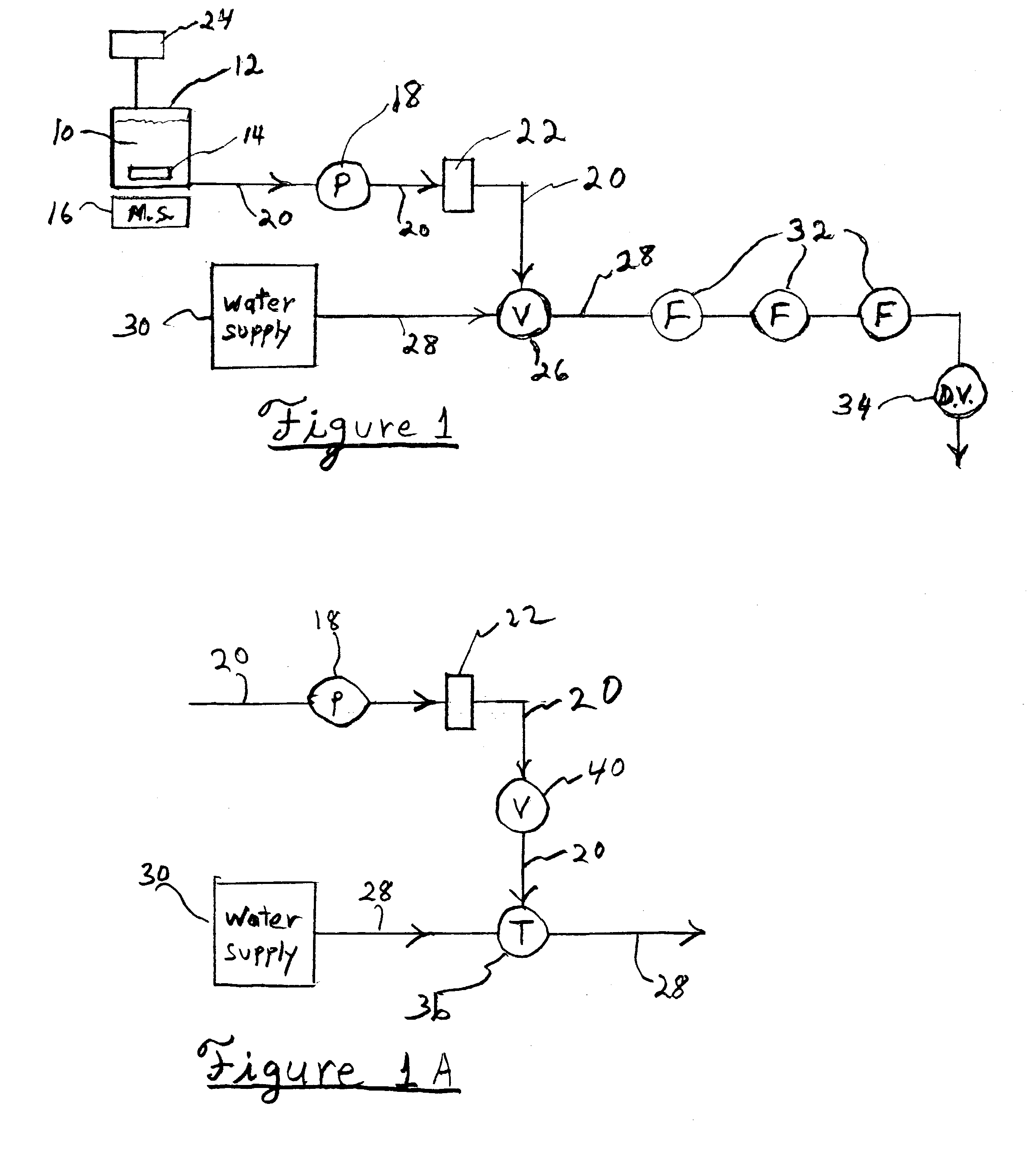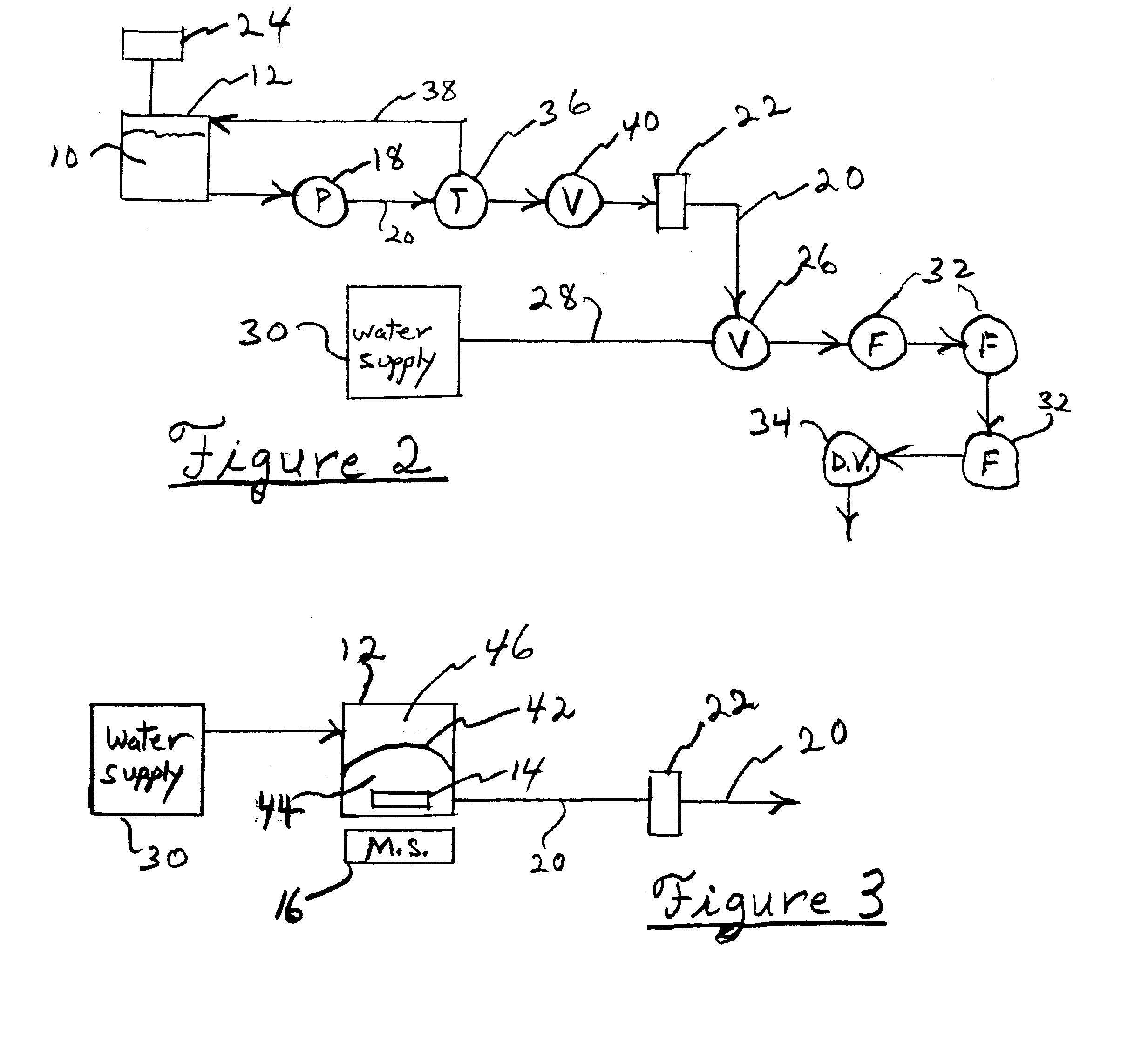Removal of biofilm from surfaces
a biofilm and surface technology, applied in the field of biofilm, can solve the problems of large microbial contamination, inability to achieve satisfactory biofilm removal from four out of ten duwl systems studied, and high contaminating microorganisms, so as to achieve simple and more effective, less complex
- Summary
- Abstract
- Description
- Claims
- Application Information
AI Technical Summary
Benefits of technology
Problems solved by technology
Method used
Image
Examples
example 1
Preparation of Bacterial Cultures
[0092] Sterile Difco Tripticase Soy Broth (TSB) (50 ml) was inoculated with Pseudomonas aeruginosa (ATCC 700829) (this bacterium is sometimes referred to herein as PA) using cells scraped from a frozen culture using sterile Pt loop. The TSB had been prepared with sterilized 18 megohm pure water. This starter culture was incubated in a 250 ml-flask at 30.degree. C. for 24 hr with shaking at 150 rpm. To prepare the culture employed to form biofilm on tubing walls, the 24-hr starter culture was added to 100 ml of (tenth strength) sterile TBS in a 250-ml flask until an OD of 0.1 was attained. This occurred after about 10 ml of 24-hr starter culture was added to the dilute sterile TSB.
example 2
Formation of Biofilm Inside Tubing
[0093] Biofilm-forming culture (100 ml prepared as described in Example 1) was re-circulated by a peristaltic pump from a reservoir through three, 18.75-inch lengths (designated I, II or III) of tubing in parallel, and returned to the reservoir. Three pump heads were used and the flow rate through each length of tubing was 150 ml / hr. The tubing [about 3 mm in outside diameter (o.d.) and about 1.5 mm in inside diameter (i.d.)] was clear polyurethane Durometer 90A obtained from A-dec, Inc. Newberg, Ore. This tubing is typically used as conduit for water in dental units (dental unit water lines, sometimes referred to as DUWLs). The reservoir was a 250-ml flask, which was continuously stirred magnetically and aerated by sparging with sterile-filtered air. Biofilm became established on the inner wall of the tubing by operating this apparatus at room temperature, under ambient lighting for seven days.
example 3
Preparation of Biofilm-Coated Tubing (BFCT) for Further Investigation
[0094] Each tubing length (designated Length I, Length II or Length III) of BFCT was removed from the re-circulation apparatus described in Example 2 and placed in a sterile petri dish. Working in a filtered laminar flow hood (Biosafety Level II), each BFCT Length was cut into four upstream segments (each 3.75 in long and designated A, B, C, D) for investigation of cleaning protocols using liquid suspensions of particles according to the present invention. Biofilm was assayed by a chemiluminescent method described more fully in subsequent examples. A fifth downstream segment (3.75 inches long) designated E was removed only from tubing length II for investigation of cleaning by a slurry protocol according to the present invention, and employing scanning electron microscopy (SEM) to assess the status of the biofilm before and after cleaning. Segment II-E was not used in experiments employing chemiluminescent measurem...
PUM
| Property | Measurement | Unit |
|---|---|---|
| density | aaaaa | aaaaa |
| time period | aaaaa | aaaaa |
| thickness | aaaaa | aaaaa |
Abstract
Description
Claims
Application Information
 Login to View More
Login to View More - R&D
- Intellectual Property
- Life Sciences
- Materials
- Tech Scout
- Unparalleled Data Quality
- Higher Quality Content
- 60% Fewer Hallucinations
Browse by: Latest US Patents, China's latest patents, Technical Efficacy Thesaurus, Application Domain, Technology Topic, Popular Technical Reports.
© 2025 PatSnap. All rights reserved.Legal|Privacy policy|Modern Slavery Act Transparency Statement|Sitemap|About US| Contact US: help@patsnap.com



